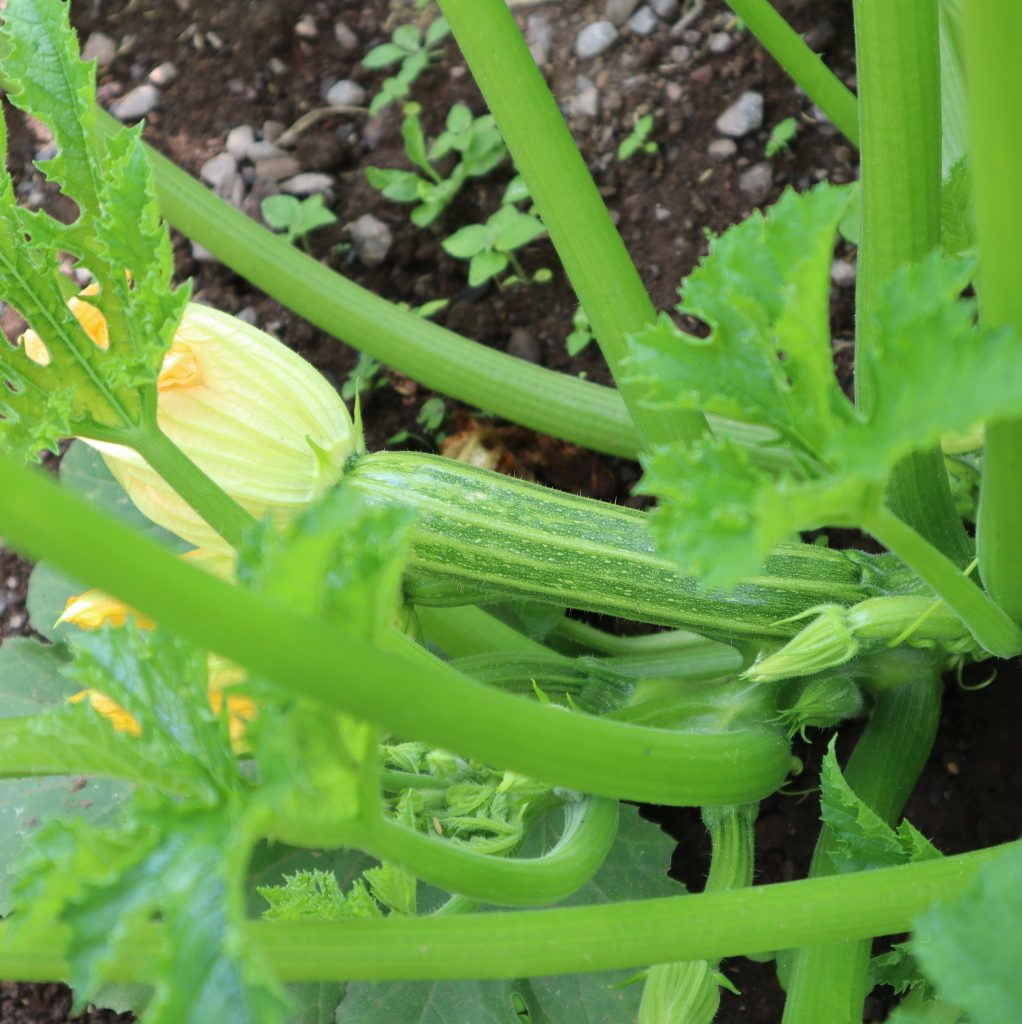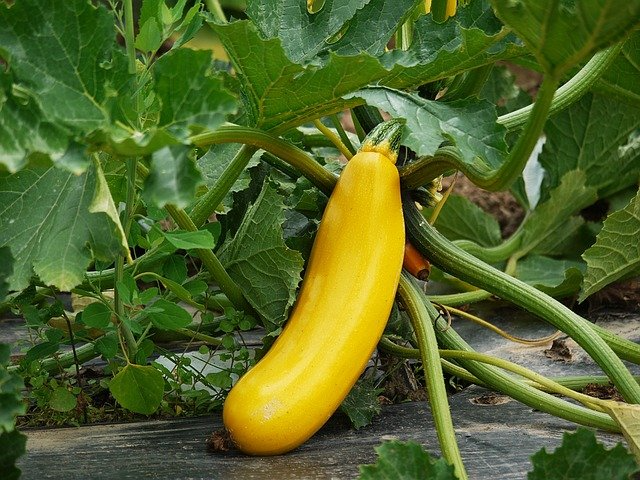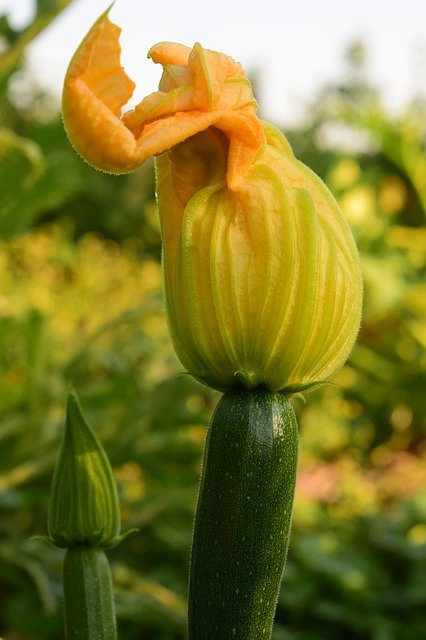How to Grow Summer Squash

Any Amazon links below are affiliate links, which means I earn a commission at no cost to you if you click and finalize an order. As an Amazon Associate, I earn from qualifying purchases.
How to Grow Summer Squash
Once summer squash start producing, there’s no end in sight! With only 2 or 3 plants you can easily have enough for eating and freezing, and there are many great summer squash family members to choose from: yellow crookneck, yellow straight neck, pattypan, and the zucchini plant, to name just a few. They are a wonderful source of added nutrition throughout the year. Here’s how to grow summer squash vertically or in the ground in the garden and containers.
How to Grow Summer Squash in the Garden
Summer squash grow well when planted in the ground, either in a garden or a raised bed. The trick is to keep them far away from other plants – give them 3 feet of space at the very least! You can start zucchini, yellow squash, patty pan, and other squash seeds from late spring well into June for a summer harvest.
Starting Seeds
For the earliest crop, you can start summer squash seeds indoors about 4 weeks before your last frost date. For most of the northeast, you should start the seeds indoors in mid April into early May. Start them in regular potting soil or a seed starting mix. Like all seeds, they’ll need watering, sunshine, and warm conditions (which you can provide with a clear plastic growing cover to mimic a greenhouse). Once the weather outside is nearly warm enough for transplanting, start hardening the seedlings off by setting them outside for an increasing number of hours each day. You can transplant them into the garden in an area with fertilized, well-drained soil when there is no more danger of frost in your area.

You can also start the seeds directly in the ground anytime from your last frost date up until July in many northeast areas for a late summer and fall harvest. Just follow the directions on your seed packet for exact dates, planting depth, and more. The soil temperature should be around 70 degrees before you plant the seeds or transplant them.
If you don’t want to deal with seeds, you can usually find young zucchini and yellow squash plants at a local greenhouse.
The traditional method for growing summer squash in the garden is in hills – you plant 3-4 seeds or 2-3 seedlings in a hill with at least 2 inches of space between each. The hills themselves should be about 6 feet apart. If hills aren’t feasible for your garden, you can also plant them in a row with 3-6 feet between each squash plant (and 3-6 feet away from any nearby plants, as well).
Before planting, consider adding a thin layer of compost or rotted manure to the area and till it in. The plants enjoy fertile soil with plenty of organic matter worked in, since they’re heavy feeders.
Proper Care
While the plants are young, keep their growing area well weeded. Once they take up about a square foot or more of space, they do a better job choking out weeds, but it can still be helpful to weed around them so you don’t miss any of your harvest.
Make sure they get plenty of water while they’re growing – around an inch a week is good for them, but avoid overwatering near the leaves.
Growing Summer Squash in Containers
Yes, you can grow these big plants outside of your garden! If you’re short on garden space, they can be just as happy in a large container as patio plants. If you’d prefer, here’s a detailed guide to growing yellow squash in containers. Otherwise, the following tips will work for growing most varieties of summer squash in containers.

Starting Seeds
Start your seeds in pots or grow bags at least 2 feet in diameter and 1 foot deep. Use good quality potting soil that drains well. Plant 2-3 seeds per container depending on pot size. The seeds should be planted about an inch deep and watered well after planting for the best results.
Proper Care
Place your summer squash pot somewhere sunny – they need at least 6 hours of full sun each day, but more than that is great! They should be watered whenever the top 2 inches of soil feel dry. Since they’re in containers, you’ll probably need to water them more often than you would a garden, so check at least once a day.
How to Grow Summer Squash Vertically
There are two different varieties of summer squash: vining and bush. Unlike winter squashes, these types of squash plants more commonly grow in bushes, but you can still find vining ones with some effort. Bush varieties won’t naturally grow vertically, but they also don’t take up as much space in a small garden. If you have vining variety squash seeds, you can train the squash to grow vertically to save room in a small space. One common vining variety is Tromboncino, which has a few characteristics of several different summer squash varieties and is resistant to squash bugs like the squash vine borer.
Growing summer squash vertically can help prevent pests and disease, make it easier to care for the plants, and, of course, save space. You can give vining summer squash support by using a tomato cage or a trellis. This works for plants grown in containers, a garden bed, or a regular in-ground garden. Pick a trellis or cage with strong wire or wood to withstand the weight of these large plants, as they’ll need extra support especially as they grow.
While it’s not usually necessary, you can sometimes set a tomato cage around a bush variety when it’s small to help keep it a little more compact. Only do this if you’re desperate to keep it small and use less space, though – it really doesn’t do anything for bush types or help save that much space. Train the leaves to go up through the cage for better success – otherwise it will just spread out through the holes.
Problems
Summer squash can suffer from a variety of problems, including pests, diseases, and more.
Watch out for pests like cucumber beetles, vine borers, and squash beetles, which feed on summer squash and can weaken the plant and spread disease. You should also keep an eye out for powdery mildew, downy mildew, bacterial wilt, and zucchini mosaic virus as well. Watch for any unusual color changes, spots, or a slowing growth rate or production.
Growing summer squash vertically to promote good air circulation can help, along with watering at the base of the plant to keep water from getting on the leaves and contributing to disease. Mulching can also help prevent disease, decrease weeds, and maintain soil moisture.
Pollination

Once the plant reaches maturity, you’ll notice it making adorable little squashes with a big flower on the end. These are the female flowers, and the ones without a squash at the base are male blossoms. If you’re growing your squash plants outdoors, squash bees and other pollinators should take care of pollinating the flowers for you.
If your plant is inside, you’ll need to hand-pollinate the flowers. Using a small paintbrush, dust some of the pollen from a male flower and brush it onto the center of the female flowers.
While the little squashes are tiny to begin with, they don’t stay small for long. They will be ready to pick about 4-5 days after the flower dies off.
Harvesting
To harvest summer squashes, use clean scissors or a sharp knife and cut the stem near the top of the squash. Most recommend picking zucchini and yellow squash when they’re 6-8 inches long. Other varieties, like pattypan, should be 3-5 inches in diameter.
You can always let them grow less or more depending on your preference and what you need them for. Just remember: picking them early and often helps keep the squashes tender and tasty and allows the plant to produce more. Since the plant slows down production when an individual squash gets too big, always pick every fruit whether you plan to use it or not. Extras can always be given away or composted.
FAQs About How to Grow Summer Squash
What is the best way to plant summer squash?
The best way to plant summer squash is to grow them in a hill with about 3-4 seeds and plenty of space on every side. You can also plant more seeds in the hill, then thin seedlings down to about 3 plants once established.
Does summer squash need a trellis?
Summer squashes don’t need a trellis, but vining varieties can be grown on them if you prefer.
How many summer squash grow on one plant?
Many summer squash can grow on one plant. Depending on the variety, you can have around three to seven squashes per week. If your summer squash produced for eight weeks, that’s 24-56 squash over the course of the growing season!
What not to plant next to summer squash?
Beets, fennel, onions, potatoes, and melons shouldn’t be planted next to summer squash.
Should I pinch off squash flowers?
You can pinch off the first blossom or two when the squash starts producing them if you want the plant to put more energy into growing larger, otherwise, you can leave them alone.
Do summer squash like sun or shade?
Summer squash love sun! They like warm weather and around 6 hours of full sun each day. You can provide this in sunny sections of the garden or sunny porches or decks for containers.
How do you tell the difference between male and female summer squash flowers?
Female summer squash flowers have a tiny squash at the base of the flower, while male flowers only have a green stem at their base.
Can I plant 2 zucchini together?
Yes, zucchini grow well when planted in a hill together. It’s a great way to save space in smaller gardens and container garden areas with limited space.
Enjoy Growing Summer Squash!
With a little bit of effort and love, your summer squash plants should flourish, bringing you plenty of delicious squash to cook, bake, and freeze! These are prolific plants that will yield a good harvest when cared for properly.
It’s good to plan some other friendly plants near your squash – here’s a full guide to squash companion plants.






